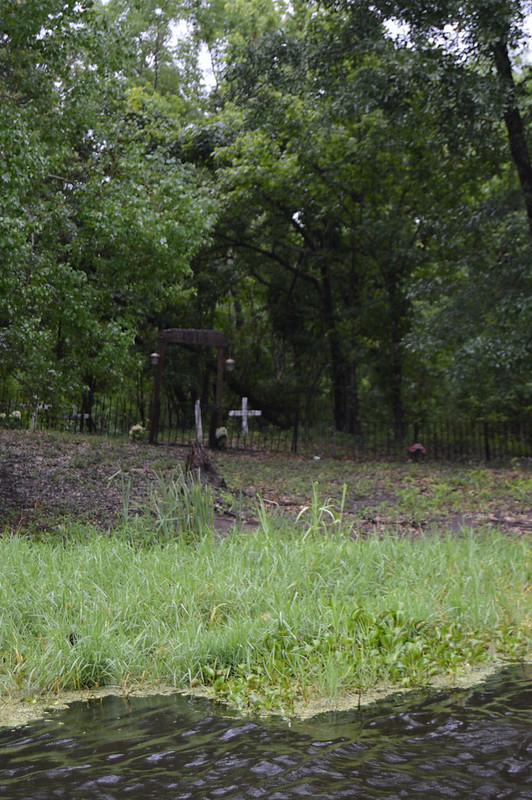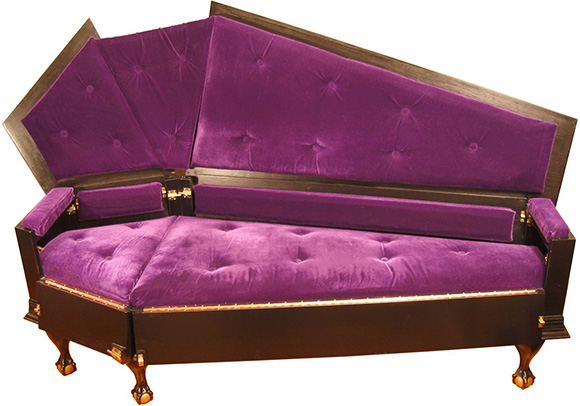
The Manchac wetlands, about a half hour northwest of New Orleans, are thick with swamp ooze. In the summer the water is pea-green, covered in tiny leaves and crawling with insects that hide in the shadows of the ancient, ghost-gray cypress trees. The boaters who enter the swamps face two main threats, aside from sunstroke and dehydration: the alligators, who mostly lurk just out of view, and the broken logs that float through the muck, remnants of the days when the swamp was home to the now-abandoned logging town of Ruddock.
But some say that anyone entering the swamp should beware a more supernatural threat—the curse of local voodoo queen Julia Brown. Brown, sometimes also called Julie White or Julia Black, is described in local legend as a voodoo priestess who lived at the edge of the swamp and served the town of Frenier. She was known for her charms and her curses, as well as for singing eerie songs with her guitar on her porch. One of the most memorable (and disturbing) went: “One day I’m going to die and take the whole town with me.”
Back when Brown was alive at the turn of the 20th century, the towns of Ruddock, Frenier, and Napton were prosperous settlements clustered on the edge of Lake Pontchartrain, sustained by logging the centuries-old cypress trees and farming cabbages in the thick black soil. The railroad was the towns’ lifeline, bringing groceries from New Orleans and hauling away the logs and cabbages as far as Chicago. They had no roads, no doctors, and no electricity, but had managed to carve out cohesive and self-reliant communities.
That all changed on September 29, 1915, when a massive hurricane swept in from the Caribbean. In Frenier, where Julia lived, the storm surge rose 13 feet, and the winds howled at 125 miles an hour. Many of the townsfolk sought refuge in the railroad depot, which collapsed and killed 25 people. Altogether, close to 300 people in Louisiana died, with almost 60 in Frenier and Ruddock alone. When the storm cleared on October 1, Frenier, Ruddock, and Napton had been entirely destroyed—homes flattened, buildings demolished, and miles of railway tracks washed away. One of the few survivors later described how he’d clung to an upturned cypress tree and shut his ears against the screams of those drowning in the swamp.
The hurricane seemed to come out of nowhere. But if you listen to the guides who take tourists into the Manchac swamp, the storm was the result of the wrath of Julia Brown. Brown, they say, laid a curse on the town because she felt taken for granted—a curse that came true when the storm swept through on the day of her funeral and killed everyone around. On certain tours, the guides take people past a run-down swamp graveyard marked “1915”—it’s a prop, but a good place to tell people that Brown’s ghost still haunts the swamp, as do the souls of those who perished in the hurricane. The legend of Julia Brown has become the area’s most popular ghost story, spreading to paranormal shows and even Reddit, where some claim to have seen Brown cackling at the edge of the water.
After I visited the swamp earlier this year and heard Julia Brown’s story, I got curious about separating fact from fiction. It turns out Julia Brown was a real person: Census records suggest she was born Julia Bernard in Louisiana around 1845, then married a laborer named Celestin Brown in 1880. About 20 years later, the federal government gave her husband a 40-acre homestead plot to farm, property that likely passed on to Julia after her husband’s death around 1914.
Official census and property records don’t make any mention of Brown’s voodoo work, but that’s not especially surprising. A modern New Orleans voodoo priestess, Bloody Mary, told mental_floss she has found references to a voodoo priestess or queen by the name of Brown who worked in New Orleans around the 1860s before moving out to Frenier. Mary notes that because the towns had no doctors, Brown likely served as the local healer (or traiteur, a folk healer in Louisiana tradition) and midwife, using whatever knowledge and materials she could find to care for local residents.
And Brown’s song is documented, too. An oral history account from long-time area resident Helen Schlosser Burg records that “Aunt Julia Brown … always sat on her front porch and played her guitar and sang songs that she would make up. The words to one of the songs she sang said that one day, she would die and everything would die with her.”
There’s even one newspaper account from 1915 that describes Brown’s funeral on the day of the storm. In the words of the New Orleans Times-Picayune from October 2, 1915 (warning: offensive language ahead):
Many pranks were played by wind and tide. Negroes had gathered for miles around to attend the funeral of ‘Aunt’ Julia Brown, an old negress who was well known in that section, and was a big property owner. The funeral was scheduled … and ‘Aunt’ Julia had been placed in her casket and the casket in turn had been placed in the customary wooden box and sealed. At 4 o’clock, however, the storm had become so violent that the negroes left the house in a stampede, abandoning the corpse. The corpse was found Thursday and so was the wooden box, but the casket never has been found.
Bloody Mary, however, doesn’t think Brown laid any kind of curse on the town. “Voodoo isn’t as much about curses as it is about healing,” she says. The locals Mary has spoken to remember Julia as a beloved local healer, not a revengeful type. In fact, Mary suggests that Julia’s song may have been more warning to the townsfolk than a curse against them. Perhaps Brown even tried to perform an anti-storm ritual and was unable to stop the hurricane before it was too late. Whatever she did, Mary says it wasn’t out of malevolence. And if she’s still in the swamp, you have less to fear from her than from the alligators.
October 31, 2016 – 5:00pm













































